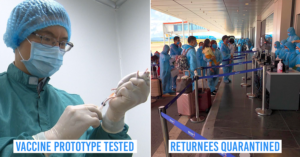Facts about diphtheria in Vietnam
2020 has been a challenging year for Vietnam, what with the COVID-19 pandemic and economic challenges following a nationwide lockdown to curb the spread of the virus.
Just when we started to think that we’re out of the woods, a new deadly disease called diphtheria emerged on 20th June in Dak Nong Province and resulted in the quarantine of over 300 Vietnamese people after it killed a 9-year-old girl.
As of 25th June, Saigon has detected its first case of diphtheria and started issuing red alerts about the disease. To protect yourself and your loved ones, here are 7 things about diphtheria that you need to know.
1. Diphtheria in Vietnam
Earlier on 20th June, the first case of diphtheria was detected in Dak Nong province. The patient was 9 years old and died shortly after being transferred to HCMC Hospital.
Several other children were also quickly detected to have contracted the same disease, prompting fear over a diphtheria outbreak. Health authorities have discovered 3 clusters in the area and quarantined up to 1,200 people. These people have also been given preventive remedies to prevent diphtheria from entering their systems.

Residents from diphtheria clusters being quarantined for surveillance
Image credit: Tuổi Trẻ
As of 25th June, Saigon reported its first case of diphtheria – a 20-year-old university student. He had been hospitalised in intensive treatment for 9 days as he gradually recovered from the disease.
Health authorities are trying their best to evaluate the potential scale of the outbreak and quarantine anyone who has come into contact with the confirmed cases of diphtheria for the past weeks.
2. Diphtheria is particularly deadly in children
According to the US Centres for Disease Control and Prevention (CDC), diphtheria is an infection caused by a bacteria called Corynebacterium diphtheriae. After the bacteria enters the body, it produces a poison that kills healthy cells.
While it can affect both the skin and respiratory system, it is the latter infection that is more deadly. Because the poison kills living cells, the dead cells can accumulate in the respiratory system and cause breathing problems.
If the toxin moves into the bloodstream, it can cause heart failure, and even damage nerves and organs such as the kidney damage. Complications from the infection can lead to death too.

A Vietnamese patient being treated for diphtheria
Image credit: vtv.vn
Diphtheria is a major cause of childhood mortality, with up to 2 in 10 children under 5 years old succumbing to the disease, according to the CDC. Even though diphtheria is most common among children from the ages of 5 to 9, it can also be found in adults who are not immunized against the disease. Figures cited from the World Health Organization (WHO) says that 5-10% of diphtheria cases result in death.
3. How diphtheria spreads and infects people
The bacteria that cause diphtheria can enter the body through the nose, mouth, and a break in the skin. It can spread from person to person through coughing, sneezing, or laughing.

Image credit: Bệnh Viêm Xoang
Touching infected open sores (a symptom of diphtheria skin infection) and even sharing a glass with an infected person can also result in transmission.
Since diphtheria is transmitted through respiratory droplets, not unlike COVID-19, wearing masks, as well as practicing good hygiene habits such as not touching your face, washing hands frequently, and not sharing food or utensils will safeguard you from contracting the disease.
4. Diphtheria symptoms
Those who have diphtheria can be asymptomatic or show only mild symptoms, which often develop 2 or 5 days after you get infected.
Early symptoms include having a sore throat, runny nose, or a fever. Others may experience swollen glands in the neck, trouble breathing, and painful skin lesions. The most visible symptom is developing a gray covering in the nose, throat, or tonsils.

Image credit: Vinmec
People infected with diphtheria, even if they don’t show visible symptoms, are contagious for up to 4 weeks if they do not receive treatment.
5. Risks of diphtheria
If left untreated, diphtheria may spread to other parts of the body, such as the heart or the brain and result in coma or death within a week.

Image credit: VNVC
Those who have recovered from diphtheria will still need to be given a full-course vaccination to curb any recurrence of the disease, because contracting diphtheria once doesn’t guarantee future immunity.
6. Prevention
The best way to prevent contracting diphtheria is to get vaccinated against it. Children from as young as 2 months old, or even 6 weeks old, as stated by the WHO, can start getting their shots.

Image credit: Tuổi Trẻ
Sanitizing your hands regularly and keeping your living environment clean can also help curtail the spread of the infection. According to an academic journal Microbiome, sunlight can help keep germs such as the bacteria that cause diphtheria, so try to keep your windows open during the day.
If you have come into close contact with someone who has contracted diphtheria, taking antibiotics can help prevent you from getting sick, according to the CDC.
7. Treatment for diphtheria in Vietnam
Patients infected with diphtheria need to be hospitalized in an intensive care unit for treatment, and given courses of antibiotics and antitoxin.

Image credit: Báo Bình Dương
Antibiotics, such as penicillin or erythromycin, can kill bacteria and clear up infections.
Antitoxin, on the other hand, is antibodies that are used to neutralize the toxins produced by the bacteria. They are usually injected into the vein or muscle of a person who’s not allergic to it. A skin allergy test is always performed before the patient is given an antitoxin.
Diphtheria in Vietnam: What you need to know
Diphtheria is not a common disease in developed parts of the world such as the United States and Western Europe, thanks to the introduction of vaccination programs in the 1970s. However, this disease still occurs in places where vaccination rates are low, and those who are infected come in contact with people from other places and help to spread the disease.
To protect your health and your loved ones, try to get immunization when you can and give your children vaccination against diphtheria at early stages of life. Washing your hands often and keeping your living space clean at all times can also help to limit the transmission of the disease.
Also check out:
- 4 things about COVID-19 Vietnam’s top health expert wants you to know
- Vietnam’s labor market picks up after COVID-19
- HCMC uses technology to assess COVID-19-related risks
- Vietnam lifts restrictions on leisure spots
Cover image adapted from: vtv.vn
Enjoying The Smart Local Vietnam? Follow us on Facebook and LinkedIn for more stories like this.

Drop us your email so you won't miss the latest news.






